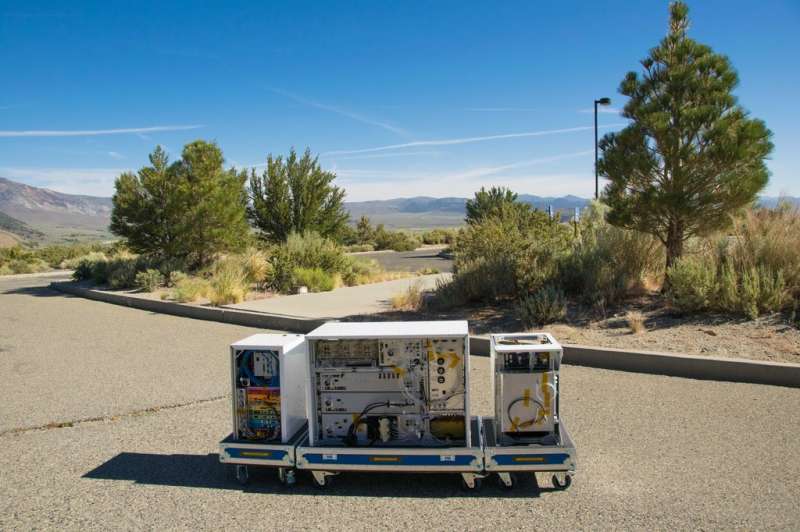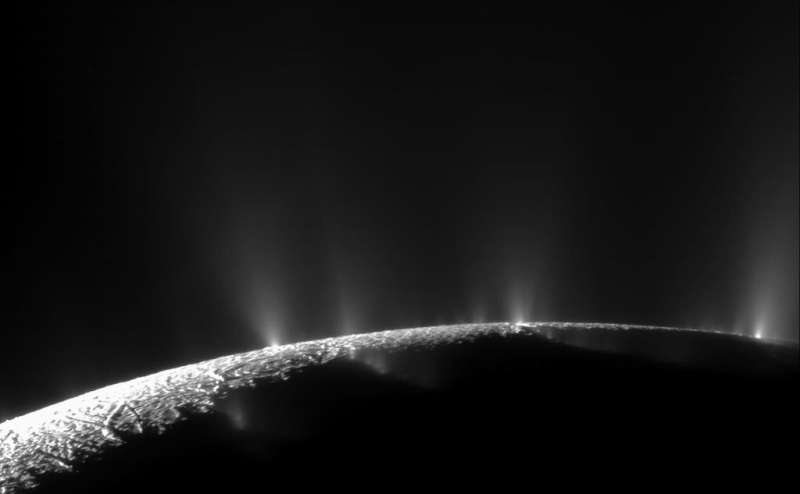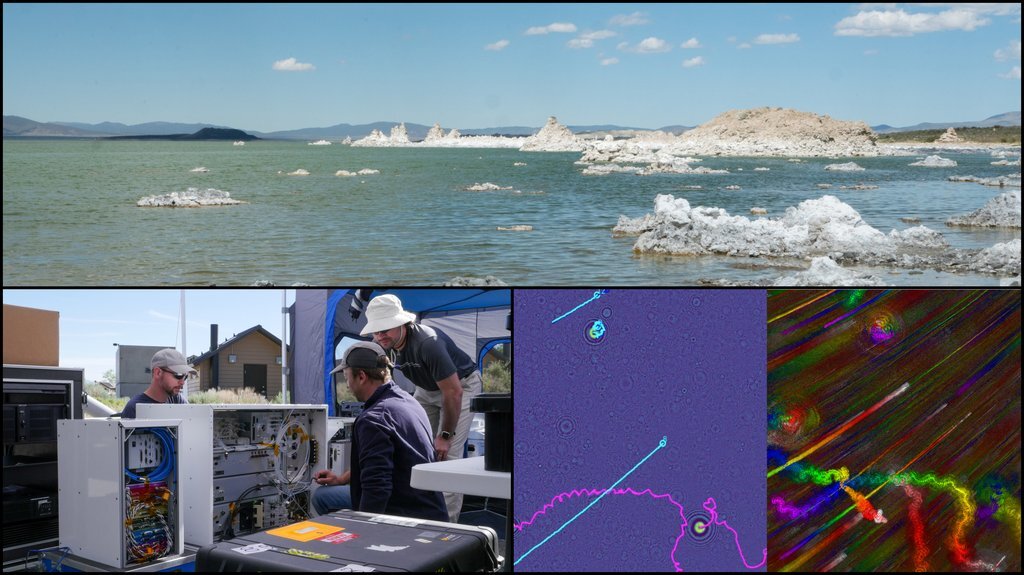Counterclockwise from top: California’s Mono Lake was a field test site for JPL’s Ocean Worlds Life Surveyor. A suite of eight instruments designed to detect life in liquid samples from icy satellites, OWLS can autonomously track the actual movements of water flowing past the microscopes. Credit: NASA/JPL-Caltech
Are we alone in the universe? The answer to this age-old question seemed eminently within reach after the discovery of ice-covered moons in our solar system with potentially habitable subsurface oceans. But searching for evidence of life in the frigid seas hundreds of millions of miles away poses enormous challenges. The scientific equipment used must be extremely sophisticated, but capable of withstanding intense radiation and cryogenic temperatures. Moreover, instruments must be able to make multiple, independent, complementary measurements that together can provide scientifically sound evidence for life.
To address some of the challenges future life-detection missions may face, a team at NASA’s Jet Propulsion Laboratory in Southern California has developed OWLS, a powerful suite of scientific instruments unlike any other. Short for Oceans Worlds Life Surveyor, OWLS is designed to swallow and analyze liquid samples. It has eight automated instruments that would require the work of several dozen people in a laboratory on Earth.
One vision for OWLS is to use it to analyze frozen water from the vapor plume ejected from Saturn’s moon Enceladus. “How do you take a blob of ice a billion miles from Earth and determine—for the one chance you have, while everyone on Earth waits with bated breath—whether there is evidence of life?” said Peter Willis, one of the project’s principal investigators and scientific director. “We wanted to create the most powerful instrument system you could design for a situation like this, to look for both chemical and biological signatures of life.”

JPL’s OWLS combines powerful instruments for chemical analysis that look for the building blocks of life and microscopes that look for cells. This version of OWLS will be miniaturized and adapted for use in future missions. Credit: NASA/JPL-Caltech
In June, after half a decade of work, the project team tested its equipment — currently the size of several filing cabinets — in the salty waters of Mona Lake in California’s Eastern Sierra. OWLS discovered chemical and cellular evidence of life, using built-in software to identify that evidence without human intervention.
“We demonstrated the first generation of the OWLS package,” Willis said. “The next step is to customize and miniaturize it for specific mission scenarios.”
Problems, solutions
The main difficulty the OWLS team faced was how to handle liquid samples in space. On Earth, scientists can rely on gravity, reasonable laboratory temperatures, and air pressure to hold samples in place, but such conditions do not exist on a spacecraft hurtling through the solar system or on the surface of a frozen moon. So the team developed two instruments that can extract a liquid sample and process it in space.
Because it is unclear what form life might take in the ocean world, OWLS also needed to include as wide a range of instruments as possible, capable of measuring the size range from single molecules to microorganisms. To this end, the project combined two subsystems: one that uses different methods of chemical analysis using several instruments, and another with several microscopes to study visual clues.
The OWLS microscope system will be the first in space capable of imaging cells. Developed in collaboration with scientists at Oregon State University in Portland, it combines a digital holographic microscope that can identify cells and movement throughout a sample, with two fluorescence cameras that use dyes to observe chemical content and cellular structures. Together, they provide overlapping views with a resolution of less than one micron, or about 0.00004 inches.

This image, taken by NASA’s Cassini mission during a 2010 flyby, shows water ice and vapor spewing from Saturn’s frozen moon Enceladus, which contains a hidden subsurface ocean. OWLS is designed to ingest and analyze liquid samples from such plumes. Credit: NASA/JPL/Space Science Institute
Dubbed the Extant Life Volumetric Imaging System (ELVIS), the microscope subsystem has no moving parts – a rarity. And it uses machine learning algorithms to both create realistic motion and detect objects illuminated by fluorescent molecules that occur naturally in living organisms or as dyes bound to parts of cells.
“It’s like looking for a needle in a haystack without having to pick up and examine each piece of hay,” said lead researcher Chris Lindensmith, who leads the microscope team. “We basically grab big haystacks and say, ‘Oh, here’s the needles here, here and here.’
To investigate much smaller forms of evidence, OWLS uses its Organic Capillary Electrophoresis Analysis System (OCEANS), which essentially boils liquid samples under pressure and feeds them into instruments that look for the chemical building blocks of life: all kinds of amino acids, as well as fatty acids and organic compounds. The system is so sensitive that it can even detect unknown forms of carbon. Willis, who led the development of OCEANS, compares it to a shark that can smell just one molecule of blood in billions of water molecules and also determine blood type. It will be only the second instrument system to perform chemical analysis of a liquid in space, after the Microscopy, Electrochemistry and Conductivity Analyzer (MECA) instrument on NASA’s Phoenix Mars Lander.
OCEANS uses a technique called capillary electrophoresis – essentially passing an electric current through a sample to separate it into its components. The sample is then directed to three types of detectors including a mass spectrometerthe most powerful tool for identifying organic compounds.
Sending home
These subsystems produce enormous amounts of data, only 0.0001% of which can be sent back to distant Earth due to data transfer rates that are more limited than dial-up internet since the 1980s. Therefore, OWLS was designed with so-called “airborne science instrument autonomy”. Using algorithms, computers will analyze, summarize, prioritize, and select only the most interesting data to send home, while offering a “manifesto” of the information that’s still being stored.
“Now we’re starting to ask questions that require more advanced instrumentation,” said Lucas Mandrake, the project’s instrument autonomy system engineer. “Are some of these other planets habitable? Is there valid scientific evidence for the existence of life, rather than a hint that it might be out there? This requires instruments that acquire a lot of data, and that is what OWLS and its scientific autonomy are designed to achieve. ”
For more information on the JPL OWLS project, please visit: www.jpl.nasa.gov/go/owls
Provided
Laboratory of jet propulsion
Citation: Team develops new tools to search for life in deep space (2022, October 6) Retrieved October 6, 2022, from https://phys.org/news/2022-10-team-tools-life-deep-space. html
This document is subject to copyright. Except in good faith for the purpose of private study or research, no part may be reproduced without written permission. The content is provided for informational purposes only.








